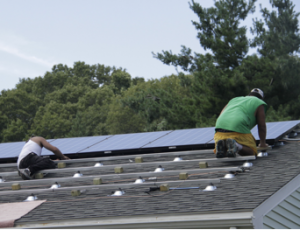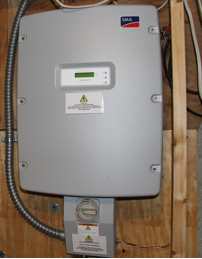This is an exciting day for the residents of a small white cape in Waltham, Massachusetts; today the new solar photovoltaic electric system goes live. A year of study is about to end and the result of all this research is about to change their source of electric power. Today their brand new solar system is getting turned on and what had only been a dream will become a reality.
Ron, the proud owner of this new solar system had lived in this house for over 40 years. He had raised his family here and he knew that he had the peAfect home for a solar system. His roof faces south, an important criteria for having the perfect roof with the right degree of tilt. He also had a hunch that the timing for this project would make it affordable. The government’s offering of rebates along with tax credits and SREC’s would help defray the initial cost, and provide a little extra money for the next ten years. All these factors would align and he would have his system.
Most certainly, “sticker shock” can prevent one from moving forward on a solar project. Solar systems are costly and their payback can seems questionable or unreasonable….
Neighbors, friends and even family questioned his decision to install a photovoltaic system. “How high is your electric bill? Or “How long is the payback?” they would ask with a shake of their heads. Neighbors voiced concerns about the appearance… would it be an eyesore or change property values? How would his system impact their street? No one was asking about the advantages, the potential savings, and what the system could provide in years to come.
Putting the sun to work makes sense, and it is now entirely possible. Solar energy can be understood by researching some simple concepts. This understanding will enable many to harness the sun and its energy and to move past the cost. Once over that hump, the sun’s energy will work for years to come and provide one with a clean and renewable source of power.
ADVICE FOR PROSPECTIVE SOLAR CUSTOMERS
How does one begin to shop for a solar photovoltaic system? The first step is to study your historic electric usage. First, like in any other planned purchase, you should have an idea of what you want to achieve. Do you want to zero out your electric bill as well as creating a source for a little extra income? How much can you afford to spend is an individual decision everyone must make for themselves.
A good first step might be to look at your previous electric bills. This is easy to do on a computer. You can simply go to your provider’s site, and login/ register into your account. Usually, its possible to see up to three years of historical energy usage and payment history. Average the payments of twelve months to get an annual usage figure, and use this average as your systems capacity reference. Ideally, you would size your system to provide electrical output to be the same as your usage, or even slightly more. Typical residential solar systems are about 5000 watts, otherwise known as a 5KW system.
Now– you are ready to begin shopping! You should limit your research to getting quotes from NABCEP (North American Board of Certified Energy Practitioners) solar installer.  Installers can be master electricians with their own crews or businesses who specialize in the installation of photovoltaic systems. You’ll likely encounter large and small businesses doing these installations and the important things to consider are experience and expertise. Do not hesitate to check out your potential installer thoroughly.
Installers can be master electricians with their own crews or businesses who specialize in the installation of photovoltaic systems. You’ll likely encounter large and small businesses doing these installations and the important things to consider are experience and expertise. Do not hesitate to check out your potential installer thoroughly.
Get references and follow up. It would be a good idea to get at least three quotes and compare them. Installers shouldn’t mind your questions, as most want you to understand what you are buying. Reputable Installers will give you several references with addresses and phone numbers. The Waltham homeowner actually visited the addresses, looked at the installation and spoke with the other homeowners. He learned that they where indeed pleased and would use the installer again, so he to chose this installer, who is a master electrician with NABCEP certification, and his own crew.
The next step is to negotiate the best contract. This includes the size of the system (solar output), the panels, inverter, mounts, etc. Then, understand the rebates (state and federal), the final price and the timeframe for the installation. There are many aspects to this part of the deal and hopefully the experienced contractor will help. You need to rely on their experience to choose the right panels for your location and the inverter(s). The circumstances of your “site” (or roof) come into play.
Shading, slope and your roof condition are important factors, so listen for possible solutions and take your time getting your questions answered. Enjoy the process.
This Waltham roof had issues with shading, as will many. Trees, wires, and obstructions such as a chimney effect the placement and performance of the panels. Solar panels “arrays” are installed in a series and shading can  seriously affect the output or in some cases shut them down. One way to think about this is to compare it to a system of Christmas tree lights. When one goes out in the series circuit, so do all the rest. A basic understanding of the fundamentals of photovoltaic electricity will help you look for solutions to get more from your system. Should you remove or trim a tree? Do you need more or higher capacity panels? How about the inverter? How do you pay the installer for the system? Discuss this in detail and get it in writing. Who gets the rebates, who applies for them are they applied to the installer’s final payment? What are SRECS and how do you get them? Tax credits?
seriously affect the output or in some cases shut them down. One way to think about this is to compare it to a system of Christmas tree lights. When one goes out in the series circuit, so do all the rest. A basic understanding of the fundamentals of photovoltaic electricity will help you look for solutions to get more from your system. Should you remove or trim a tree? Do you need more or higher capacity panels? How about the inverter? How do you pay the installer for the system? Discuss this in detail and get it in writing. Who gets the rebates, who applies for them are they applied to the installer’s final payment? What are SRECS and how do you get them? Tax credits?
Once the contract is signed, the equipment gets ordered. The contractor has pulled the permits and will begin as soon as all the equipment is shipped to the location– so make room in your garage! The actual installation should only take a few days and is exciting to watch. In Waltham, the roof was in poor repair and needed to be replaced so the installation was coordinated with a new roof. The roof was then prepared for the installation of the panels. Mounts and brackets were secured to the roof and then 30 Kyrocera 210 watt panels were raised,  wired and installed. One “Sunny Boy” SB7000 inverter was snuggly fit into the basement and fixed with a internet connection. This wireless connection enabling one to watch the energy output on-line! Finally, all the necessary paperwork is submitted to schedule the final inspection. The electric utility is notified that the roof is ready to go live.
wired and installed. One “Sunny Boy” SB7000 inverter was snuggly fit into the basement and fixed with a internet connection. This wireless connection enabling one to watch the energy output on-line! Finally, all the necessary paperwork is submitted to schedule the final inspection. The electric utility is notified that the roof is ready to go live.
On July 22, 2010, the Waltham system was turned on. The inverter came to life and displayed the power of the panels in digital numbers; we saw the net meter begin to turn backward! Now neighbors stop by often insisting they to “want to get one.” Others see the panels and simply stop and ring the bell to request information. They want details and are excited by the possibility.
Going green has proven to be easier then anticipated, the payback much quicker, and the “good” feeling from reducing ones carbon footprint totally gratifying so make the effort you might just be pleasantly surprised!
Want to get NABCEP certified and learn to install a solar system?
The Solar PV Installer Boot Camp + NABCEP Entry Level Exam Prep training teaches you to design, install, and sell solar photovoltaic (PV) systems. It also prepares you to pass the NABCEP Entry Level Exam. The course includes lecture videos, useful resources, practice quizzes, and discussion board access to instructor Sean White, a certified NABCEP PV Installation Professional and globally-recognized solar educator and author.










For this particular installation, is there some info available on the installation costs, tax credits obtained, and the projected payback period? Also, what was the home’s average electrical use per month?
Everyone understands how this is a good way to save energy and better use our resources, but until the building industry moves away from the “up-front cost” mentality, the first question from every client is to ask about the install costs and payback period.
This installation was in the $30,000 to 35,000 dollar range. His electric bill on average had been about $180.00 a month. The re-bate for the project was approximately 10,000 and was paid to the installer. He will receive Massachusetts SREC, and a 30% tax credit on the system. His out of pocket expense was about $20,000. This system should be paid back in about 3 to 4 years depending on the sunshine. I checked with the homeowner who said ” I would do it again in a heartbeat, but I would go bigger!”
His electric bill has become a credit, since installing the system . He now uses some electric space heaters so he saw a significant reduction in his oil bill!
Thank you for your interest, and comments,
P. Vartanian
It’s important to note that the MA SREC credits for solar in is between $300 MWh ($.30 kWh) and $600MWh ($.60 kWh) IN ADDITION to the cost of the electricity it offsets for a guananteed 10 year. This means if you’re paying $.15 kWh, each kWh that solar produces is worth $.45 kWh…..which is a lot!
Chris